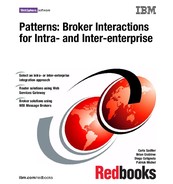
18 Broker Interactions for Intra- and Inter-enterprise
2.1 The need for a unifying technique
There are many existing techniques and disciplines for integration. These are
currently fragmented into stovepipes. Therefore, there are problems identifying
the best techniques to use and problems in using different techniques together.
In particular, terminology is a problem. Each of these disciplines often uses
overloaded or ambiguous terminology that inhibits cross-discipline dialog. Use of
similar terms in different domains may also mask incompatibilities that only
become apparent at lower levels of design. EAI and B2B provide a good
example: they have traditionally been seen as very different, whereas a simple
diagram shows that they are solving some very similar problems.
Table 2-1 provides an example of terminology overload for “synchronous verses
asynchronous.
Table 2-1 Synchronous verses asynchronous terminology overload
These inconsistencies significantly complicate the Process Integration efforts by
impeding communication between different groups of skill sets needed to
implement the end-to-end integration solution.
2.1.1 Similarities between intra- and inter-enterprise integration
As shown in Figure 2-1 and Figure 2-2, intra-enterprise integration and
inter-enterprise integration are both concerned with integrating source and target
applications.
Figure 2-1 Intra-enterprise integration
Domain Meaning
Networking Used to differentiate protocols that can detect
transmission errors via acknowledgement
messages
Application programming Used to indicate whether the caller waits (blocks)
until the operation completes
Messaging Used to differentiate services that can store and
forward messages (avoiding the need for all linked
services to be available)
Source
Application
Target
Application
..................Content has been hidden....................
You can't read the all page of ebook, please click here login for view all page.
